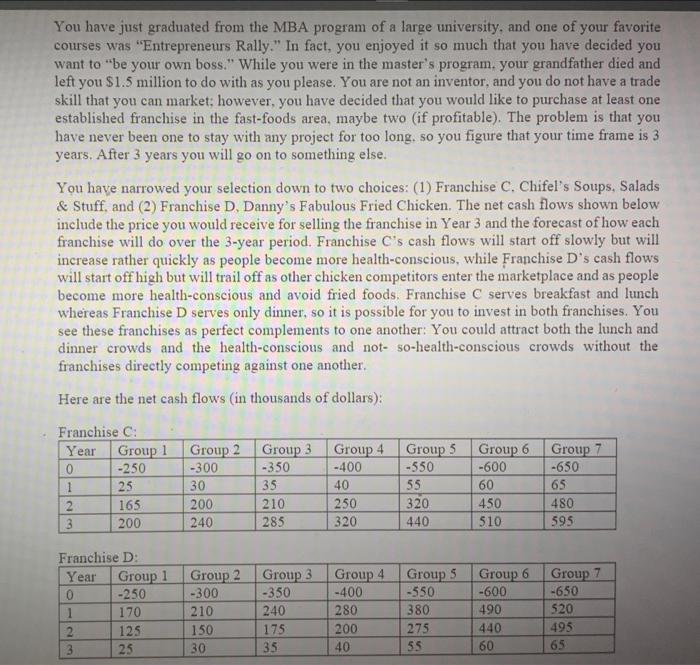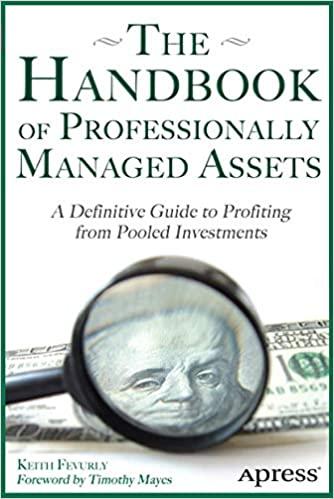You have just graduated from the MBA program of a large university, and one of your favorite courses was "Entrepreneurs Rally." In fact, you enjoyed it so much that you have decided you want to "be your own boss." While you were in the master's program, your grandfather died and left you $1.5 million to do with as you please. You are not an inventor, and you do not have a trade skill that you can market; however, you have decided that you would like to purchase at least one established franchise in the fast-foods area, maybe two (if profitable). The problem is that you have never been one to stay with any project for too long, so you figure that your time frame is 3 years. After 3 years you will go on to something else. You have narrowed your selection down to two choices: (1) Franchise C. Chifel's Soups, Salads & Stuff, and (2) Franchise D. Danny's Fabulous Fried Chicken. The net cash flows shown below include the price you would receive for selling the franchise in Year 3 and the forecast of how each franchise will do over the 3-year period. Franchise C's cash flows will start off slowly but will increase rather quickly as people become more health-conscious, while Franchise D's cash flows will start off high but will trail off as other chicken competitors enter the marketplace and as people become more health-conscious and avoid fried foods. Franchise C serves breakfast and lunch whereas Franchise D serves only dinner, so it is possible for you to invest in both franchises. You see these franchises as perfect complements to one another: You could attract both the lunch and dinner crowds and the health-conscious and not-so-health-conscious crowds without the franchises directly competing against one another. Here are the net cash flows (in thousands of dollars): Franchise C: Year 0 1 2 3 Group 1 -250 25 165. 200 Franchise D: Year 0123 Group 1 -250 170 125 25 Group 2 -300 30 200 240 Group 2 -300 210 150 30 Group 3 -350 35 210 285 Group 3 -350 240 175 35 Group 4 -400 40 250 320 Group 4 -400 280 200 40 Group 5 -550 55 320 440 Group 5 -550 380 275 55 Group 6 -600 60 450 510 Group 6 -600 490 440 60 Group 7 -650 65 480 595 Group 7 -650 520 495 65 Depreciation, salvage values, net working capital requirements, and tax effects are all included in these cash flows. You also have made subjective risk assessments of each franchise and concluded that both franchises have risk characteristics that require a return of 12.5%. You must now determine whether one or both of the franchises should be accepted. d. Define the term modified IRR (MIRR). Find the MIRRS for Franchises C and D. What does the profitability index (PI) measure? What are the PIs of Franchises C and D? f. (1) What is the payback period? Find the paybacks for Franchises C and D. (2) According to the payback criterion, which franchise or franchises should be accepted if the firm's maximum acceptable payback is 2 years and if Franchises C and D are independent? If they are mutually exclusive? (3) What is the discounted payback periods for Franchise C and D? e. You have just graduated from the MBA program of a large university, and one of your favorite courses was "Entrepreneurs Rally." In fact, you enjoyed it so much that you have decided you want to "be your own boss." While you were in the master's program, your grandfather died and left you $1.5 million to do with as you please. You are not an inventor, and you do not have a trade skill that you can market; however, you have decided that you would like to purchase at least one established franchise in the fast-foods area, maybe two (if profitable). The problem is that you have never been one to stay with any project for too long, so you figure that your time frame is 3 years. After 3 years you will go on to something else. You have narrowed your selection down to two choices: (1) Franchise C. Chifel's Soups, Salads & Stuff, and (2) Franchise D. Danny's Fabulous Fried Chicken. The net cash flows shown below include the price you would receive for selling the franchise in Year 3 and the forecast of how each franchise will do over the 3-year period. Franchise C's cash flows will start off slowly but will increase rather quickly as people become more health-conscious, while Franchise D's cash flows will start off high but will trail off as other chicken competitors enter the marketplace and as people become more health-conscious and avoid fried foods. Franchise C serves breakfast and lunch whereas Franchise D serves only dinner, so it is possible for you to invest in both franchises. You see these franchises as perfect complements to one another: You could attract both the lunch and dinner crowds and the health-conscious and not-so-health-conscious crowds without the franchises directly competing against one another. Here are the net cash flows (in thousands of dollars): Franchise C: Year 0 1 2 3 Group 1 -250 25 165. 200 Franchise D: Year 0123 Group 1 -250 170 125 25 Group 2 -300 30 200 240 Group 2 -300 210 150 30 Group 3 -350 35 210 285 Group 3 -350 240 175 35 Group 4 -400 40 250 320 Group 4 -400 280 200 40 Group 5 -550 55 320 440 Group 5 -550 380 275 55 Group 6 -600 60 450 510 Group 6 -600 490 440 60 Group 7 -650 65 480 595 Group 7 -650 520 495 65 Depreciation, salvage values, net working capital requirements, and tax effects are all included in these cash flows. You also have made subjective risk assessments of each franchise and concluded that both franchises have risk characteristics that require a return of 12.5%. You must now determine whether one or both of the franchises should be accepted. d. Define the term modified IRR (MIRR). Find the MIRRS for Franchises C and D. What does the profitability index (PI) measure? What are the PIs of Franchises C and D? f. (1) What is the payback period? Find the paybacks for Franchises C and D. (2) According to the payback criterion, which franchise or franchises should be accepted if the firm's maximum acceptable payback is 2 years and if Franchises C and D are independent? If they are mutually exclusive? (3) What is the discounted payback periods for Franchise C and D? e









